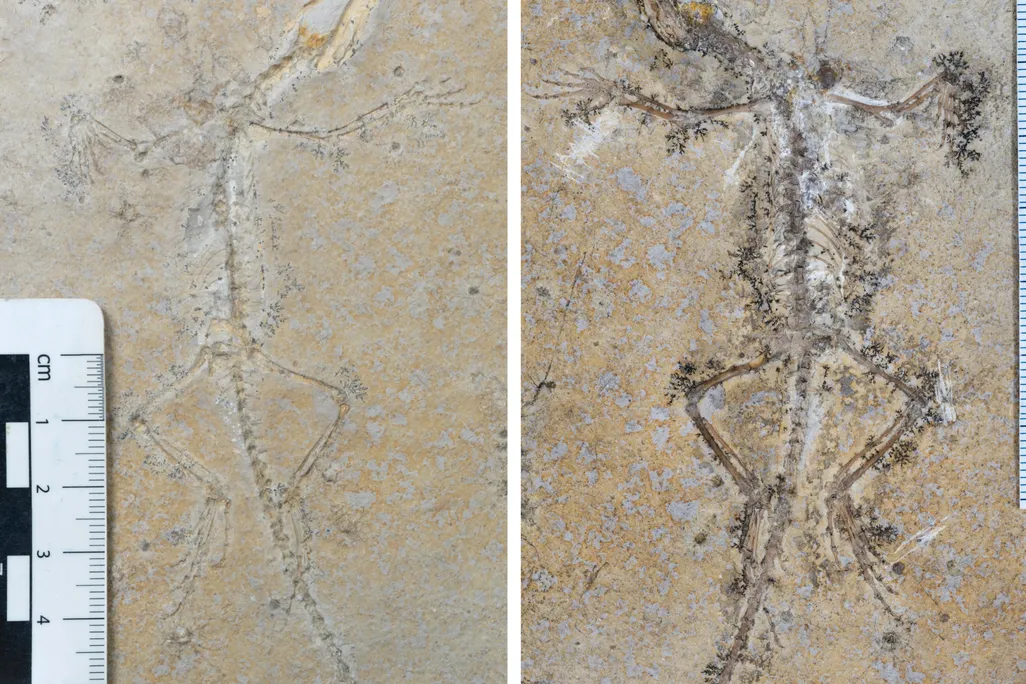A Paleontologist Matched Two Halves of the Same Fossil Stored at Different Museums—and Discovered a New Species
Meet Sphenodraco scandentis, a tree-dwelling, lizard-like reptile that roamed around with the dinosaurs during the Late Jurassic period roughly 145 million years ago

Paleontologist Victor Beccari was looking through the fossilized reptiles housed at London’s Natural History Museum when he came across a specimen that stopped him in his tracks.
The fossilized skeleton of a lizard-like reptile looked oddly familiar to him. He remembered seeing the preserved impression of a similar creature at the Senckenberg Natural History Museum in Frankfurt, Germany.
Upon further investigation, Beccari realized the two specimens were not just similar—they were two halves of the same whole. Nearly a century ago, someone had split open the flat fossil slab, leaving the skeleton in one half and the skeleton’s outline in the other.
“It seems that someone in the 1930s decided to double their profit by selling both halves separately,” Beccari says in a museum statement. “As they didn’t tell either buyer that there was another half, the connection between the two fossils had been lost until now.”
Beyond reuniting the fossils, Beccari and his colleagues made another stunning revelation: The 145-million-year-old creature belongs to a new species that was previously unknown to scientists. They describe the animal, which they named Sphenodraco scandentis, in a new paper published July 2 in the Zoological Journal of the Linnean Society.
S. scandentis belonged to a group of reptiles called rhynchocephalians. While massive dinosaurs stomped around during the Triassic, Jurassic and Cretaceous periods, these little creatures were skittering around under their feet. Today, just one species of rhynchocephalian remains in existence: the tuatara, which is New Zealand’s largest reptile.
Need to know: What are rhynchocephalians?
Although they look like lizards, rhynchocephalians are a different reptile group. They’re the closest relatives of the squamates, the group to which lizards and snakes belong. Rhynchocephalians thrived during the Mesozoic Era and took on various lifestyles, such as eating plants, hunting insects and dwelling in aquatic settings.
By studying S. scandentis’ fossilized remains and comparing them to CT scans of various lizards, researchers have been able to piece together clues about the extinct creature’s lifestyle.
S. scandentis had long limbs, a short body and long finger bones—similar to the Bronchocela crested lizards and Draco flying lizards of today, Beccari shares on social media. Based on the proportions of S. scandentis and the habitat preferences of Bronchocela and Draco, he suspects the prehistoric species probably spent most of its time in the trees. It’s now the oldest tree-dwelling rhynchocephalian scientists have ever discovered.
Hi everyone and please welcome the new Jurassic rhynchocephalian, Sphenodraco scandentis!
— Victor Beccari (@beccarivictor) July 2, 2025
Art by the amazing @SerpenIllus pic.twitter.com/xycWsW2Z5k
Before it was split in half, the S. scandentis fossil was unearthed from a layer of rock in southern Germany called the Solnhofen Limestone. Among paleontologists, this region is famous for producing well-preserved fossils from the Late Jurassic period, a time when the area consisted of islands in a subtropical sea.
Numerous rhynchocephalian fossils have been excavated from those rocks. But “although the area of Solnhofen has provided many beautiful complete skeletons of rhynchocephalians, their skulls are sometimes crushed, or part of the skeleton are still buried in the rock,” says study co-author Marc Jones, curator of fossil reptiles and amphibians at the Natural History Museum, in a statement.
Even among the well-preserved fossils, paleontologists hadn’t spent a lot of time investigating their unique attributes and traits, until recently. Historically, researchers gave some of the fossils only vague descriptions, and they tended to lump together similar-looking specimens found in the same area.
“Everything with longer limbs [from the Solnhofen Limestone] was called Homoeosaurus, and everything with shorter limbs was Kallimodon,” Beccari says in the statement.
That likely explains why the impression of the fossil housed at the Senckenberg Natural History Museum in Germany had long been classified as Homoeosaurus maximiliani. When Beccari and his colleagues took a closer look, they saw that the fossilized creature’s teeth and hip bones were not a match for H. maximiliani. It was a case of mistaken identity.
Now, however, they’ve set the record straight by identifying the animal as S. scandentis. Their research suggests even more new species could be identified from museum collections in the future.
“I’m going back over existing fossils to look for signs that other currently accepted species might cover multiple rhynchocephalians,” Beccari says in the statement. “There are also still a number of undescribed specimens that may also represent new species as well. … Even though many of these fossils were discovered almost two centuries ago, there’s still a lot they can teach us.”
/https://tf-cmsv2-smithsonianmag-media.s3.amazonaws.com/accounts/headshot/SarahKuta.png)
